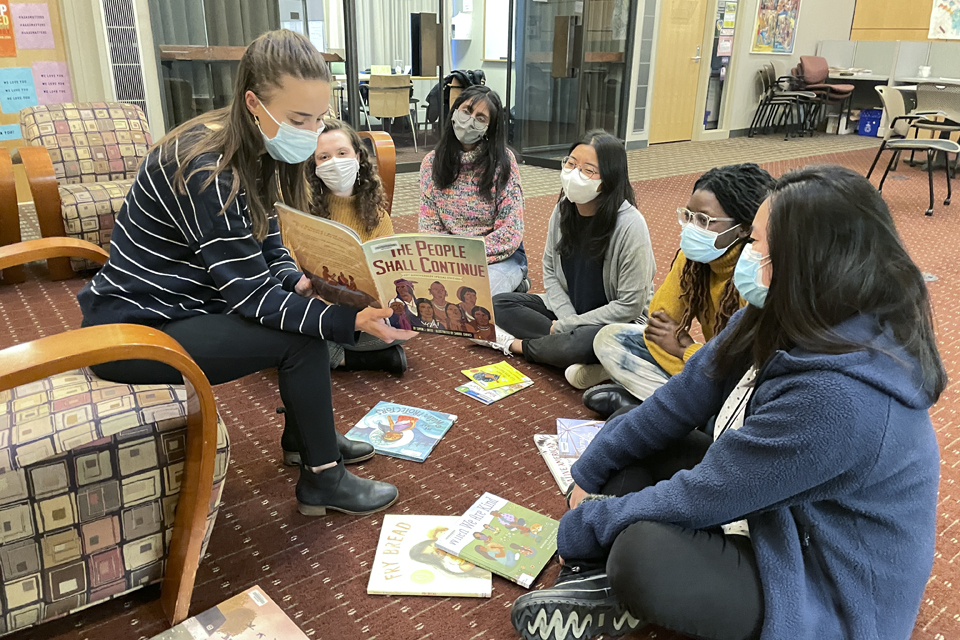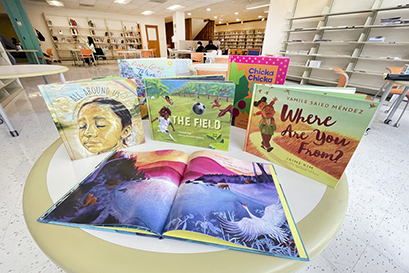Creating inclusive elementary school classrooms
Faculty and staff across Brandeis are joining forces to expand access to inclusive children’s literature
 Photo/Mike Lovett
Photo/Mike LovettStudents in a course on teaching literacy in elementary school practice reading to each other as if they are reading to an elementary school class. Senior instructor Rachel Kramer Theodorou is helping her students learn how to select books for their future classroom libraries that reflect their young students' cultures and experiences.
Everyone has a favorite book from their childhood. The book that they reached for each day growing up, marveling at the colorful pictures as a grownup read the playful text aloud.
These books formed our first understanding of identity and our sense of belonging. Seeing characters that look like us and have similar life experiences also makes it easier for us to learn information from storytelling.
Working from research that shows the importance of diverse characters in kids’ reading materials, faculty and staff across Brandeis are joining forces to expand access to inclusive children’s literature, motivating the next generation of teachers to create a thoughtful learning environment for their future students.
“This was during the start of the multicultural education reform movement,” said Theodorou.

The Brandeis Library is building a collection of children's books that highlight more diverse experiences and cultures than had been represented in kids' books in the past.
Schools were beginning to curate diverse book collections, but it was a movement with goals of increasing 'representation', particularly within classrooms of mostly white children. In 1990, Nadine Sims Bishop's “Windows and Mirrors” analogy helped educators shift away from representation toward using literature to empower all kids and their various identities — enabling them to better see themselves (mirrors) and increasing understanding of and connection to others (doors). "Her work enabled teachers to consider the important literacy and social-emotional benefits of representation for all kids,” said Theodorou.
Today as a professor in the education program, Theodorou emphasizes the use of texts with diverse characters in her Elementary Teaching and Learning 3: Literacy course. Throughout the semester, her students contemplate their own biases and discuss their encounters with human differences including race, ethnicity and language. The students then select and evaluate children's literature to meet the goals of elementary teaching using materials that resonate culturally with kids.
Theodorou’s students are learning how to teach in elementary classrooms, but are also realizing the impacts of representation on their own and their students' feelings of belonging and opportunity in school. The work goes beyond selecting material that matches the given curriculum. These assignments are building skills for a career- long mission to promote inclusion and equity in elementary classroom teaching.
“We aren’t just teaching our students to pick up books,” said Theodorou. “We want them to become thoughtful educators that fill their classrooms with literature their students feel seen in.”
This focus has received a positive response from students. “You can see their excitement as they practice reading these pieces to each other,” said Theodorou. “They are choosing books for their future classrooms, but also find themselves identifying with the characters they didn’t see in their own childhood.”
“I hope to be the kind of teacher that makes students feel valued and important,” said Jackie Mundis ’22, a senior and dual degree BA/MAT student in elementary teacher education. “I now truly realize how children's books can transform a student's relationship with themselves, one another, and their education.”
Theodorou uses resources found in the Brandeis library’s inclusive literature collection. “My students often find their course requirements right on campus at the library,” she said. “They are building an impressive collection of picture books.”
Librarians Zoe Weinstein and Alex Willett are passionate about their growing collection of early education and young adult books. The two are thoughtful in their process, reviewing award winning books and taking requests from members of the community. “We want students to have accessible resources, rather than needing to go to the local library,” said Willett.
They have noticed the collection is also used by sociology and Women’s, Gender and Sexuality Studies classes in addition to the education program, and they’re hoping to expand it to other departments on campus. “We’d love to see art students using the collection to draw inspiration for illustrations,”said Willett. “There’s lots of creative ways that these resources can be used.”
In addition to using the collection for courses, students have borrowed the books to use within their own homes. “Some of our students have families and read to their children,” said Weinstein. “We want these kids to see themselves and identify with the characters they fall in love with.”
Categories: Humanities and Social Sciences





